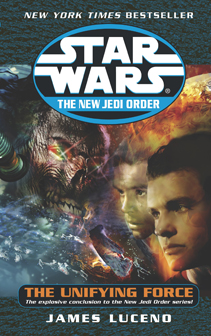The “New Jedi Order” closes out its 19-book run with James Luceno’s epic “The Unifying Force”(2003), which feels every bit of its 527 pages and must be read over several sittings. In the end, it’s a respectable conclusion to the saga, sometimes trying too hard to be “big” – like when Jacen fights the enemy by turning into a pillar of light in a throne room that blasts into space – but mostly earning its scope with satisfying answers to the long-simmering mysteries and a good grasp of most of the characters.
Luceno’s strength – as it was in the “Agents of Chaos” duology — is writing Han Solo, even though he’s a supporting player here. In many post-“Return of the Jedi” novels, Han is a shell of his former self, but in “The Unifying Force,” every line of dialogue and every behavior choice from Han is spot-on – culminating in his daring flight of the Falcon into the World Brain’s headquarters on Coruscant. A classic Han moment comes during a chase scene on the Caluula space station: Han has a spur-of-the-moment plan for C-3PO to speak to the Yuuzhan Vong in their own language to send them in the wrong direction. It feels like something he’d do in a Brian Daley book.
It’s an OK twist when we learn that Onimi – supposedly a Shamed One “pet” of Shimmra – has actually been manipulating Shimmra like a puppet throughout the series. It doesn’t contradict anything we’ve seen previously, but on the other hand, there aren’t any subtle clues that we can go back and find. And since Onimi only appears in the back half of the “NJO” saga, a reader can’t help but suspect that this character was a late-arriving idea from the editorial team.
I find the explanation of the Zonama Sekot mystery to be satisfying, though, and rather brave. The living planet is the offspring of the Yuuzhan Vong’s homeworld, the original Yuuzhan’tar. That’s merely a cool idea that nicely ties in with “Rogue Planet,” but what’s particularly daring about “The Unifying Force” is the way it expands the concept of the Force without contradicting previous notions.
The whole “NJO” plays like a lesson in different ways to look at the Force, similar to how there are different denominations within the same religion. Matthew Stover’s “Traitor” controversially introduced the Potentium, the notion that there is no light side and dark side, but merely people choosing to use the Force for good or ill. “Light and dark do not always stand opposed, but mingle with each other in curious ways,” Luke says on page 505 of “The Unifying Force.”
Taking this idea a step further, the Vong don’t exist “outside the Force,” as it seemed from the Jedis’ perspective. Rather, because they worked against the Force – becoming a species entirely devoted to war and conquest – they couldn’t be sensed in the Force. When they abandon that philosophy at book’s end, Luke and other Jedi are able to sense them.
As Luke explains:
“The Force seems to have a will, and it’s when we’re acting against the will of the Force that we can get into trouble. Anger by itself is not the dark side unless it is accompanied by a desire to dominate. When we act in harmony with the will of the Force, we disappear into it. When we struggle against it, we not only sever our ties with the Force, but also feed the needs of chaos.”
Some fans think Luceno’s book contradicts or retcons “Traitor” in the sense that “Traitor” says the Force is neutral and “The Unifying Force” says the Force encourages good behavior and/or punishes bad behavior. Yet the two explanations don’t contradict each other, and I think the writings of both authors are rather beautiful for a fictional religion.
For someone who is one of my top 10 “Star Wars” writers (and that’s not an uncommon opinion), Luceno misfires on some things in “The Unifying Force,” I must admit.
The “Return of the Jedi” parallel is present in the details, such as the conclusive throne-room battle, and in the broad scope: “The Unifying Force” feels like an early George Lucas draft of “Jedi.” In the classic trilogy, Lucas famously overwrote every movie in the early drafting stages (“Jedi” originally had two Death Stars and more theaters of battle), then whittled them down to the great – but less sprawling – films we know and love.
“The Unifying Force” often has a messy feel of an early draft, particularly in regard to the battles other than those at Caluula (where Alpha Red is unleashed), Coruscant and Zonama Sekot. I have no idea what the point of the skirmishes at Mon Calamari, Muscave and elsewhere were about, despite reading dozens of pages on the subjects.
Luceno provides so much detail of which hyperspace lanes the various space navies are using that the book sometimes reads like a galactic atlas. At other times, it reads like a “Star Wars” history book, like when he wraps up every aspect of the war’s end into a neat bow in the final 40 pages. The author’s completeness is exhaustive, and it borders on exhausting. “The Unifying Force” doesn’t leave any gaps for a reader to fill in.
And sometimes he contradicts himself as he pontificates about “Star Wars” lore. Luceno takes pains to note that the Empire fell apart when the Emperor died because Palpatine was controlling the battle with the Force, but conversely, the Vong do not operate in that way; thus, Shimmra’s death does not mark the end of the war. But then it mostly does, because the Vong take Shimmra’s death as a sign that the gods are disavowing them.
The Empire’s fall was supposedly clean and the Vong’s fall is supposedly messy, yet it seems the opposite is true: The New Republic would battle the Imperial Remnant for another solid decade, whereas the Vong don’t re-emerge as an enemy after the “NJO” (although the aftereffects of their Vongforming are still present, particularly on Coruscant). A peace truly is forged at Zonama Sekot, which takes in the surviving Vong and helps them reconnect with their pre-war ways.
Other problems: Luceno refers to Talon Karrde as Talon, despite the fact that Timothy Zahn always calls him Karrde. C-3PO speaks eloquently about his feelings in a way that no droid ever should; not even the cartoon 3PO sounded so bluntly human. Admiral Ackbar dies, but you’ll miss it if you blink. The pacifistic Zonama Sekot won’t allow warships to land, but later it does; the author gives himself logistical headaches for no good reason.
“The Unifying Force” plays best when Luceno isn’t trying too hard to be epic. Boba Fett hadn’t appeared at all in the “NJO,” yet when he helps Han at the Caluula space station, it’s a satisfying cameo – mysterious for a while, then very cool when we get the reveal. Throw in the fact that Pellaeon gives the Killik Twilight artwork (from “Tatooine Ghost,” published just prior to this book) to Leia, and the stage is nicely set for the “Dark Nest” trilogy and the “Legacy of the Force” series. Luceno achieves that most pervasive of “Star Wars” EU tricks – each book makes me want to read the next one, even on my second time through the narrative.
As a whole, the “New Jedi Order” is a journey worth taking (and re-taking). It introduces a fresh batch of characters to adult readers, reinvigorating the saga without ignoring the classic heroes by any means. Previous books focused on Luke’s generation, later books had Jacen and Jaina as main characters. Here, we get a perfect balance: Luke kills the supposed Supreme Overlord, Shimmra, but Jacen kills the actual Supreme Overlord, Onimi.
Tying in with this generational hand-off, the “NJO” is also the series that made it OK to have non-movie characters as main characters. “Traitor,” starring Jacen Solo, was the first novel to feature zero movie characters. In the wake of the “NJO,” dozens of novels – many of them set centuries or millennia before “Episode I” and exploring the earlier days of the Jedi and Sith – featured no one from the movies.
Throughout the 19 books, Jacen, Jaina and Tahiri convincingly go from kids to adults, and the “Star Wars” line of novels matures along with them. When Han gets bitten by an amphistaff in “The Unifying Force,” it’s conceivable that he will die, as Chewie and Anakin did earlier in this series. A reader didn’t get that same feeling in the 1990s novels, even though some of them were great. This saga takes a new angle on the Force, and it does so purposefully, rather than by accident, as might’ve happened in the Bantam era.
The “New Jedi Order” wasn’t content to expand the universe by adding new planets and characters, but also by expanding the possibilities of what could happen in a “Star Wars” book. It’s a turning point – and a high point – of the Expanded Universe.


